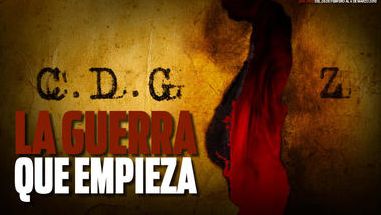
The chatter began in September 2009. Mass emails and rumors began circulating stating relationships were being broken and new, previously unimaginable alliances, were being formed. “The War”, as it was being called, was said to begin mid-month. I remember thinking: Just in time for Independence Day. Of course, September turned into October, October to November, and by the time New Years 2010 came and went, it was pretty much considered just another rumor.
On February 24, 2010 hundreds of trucks marked with C.D.G, XXX, and/or M3 hit the streets of northern Tamaulipas.
On that same day a tsunami of violence overwhelmed cities and towns south of the border with Texas. Shootings and grenade attacks in Nuevo Laredo, Reynosa, Cd. Mier, Matamoros, Valle Hermoso, and Rio Bravo forced schools and businesses to close. The U.S. consulates and American Citizen Services closed in at least two of the border towns, with no specific date for resuming services.
For several days citizens remained locked in their homes. They watched in fear, shock and dismay as their towns became war zones. Neither police nor the military came to their rescue.
In Nuevo Leon, similar acts occurred. Unprecedented violence and executions also spread throughout the state, beginning in the towns on the state line with Tamaulipas and spreading to the mountain city of Monterrey.
The violence is said to have derived from the breaking of an agreement which was made between the Gulf Cartel and the Zetas.
After the 2003 arrest and subsequent extradition of Gulf Cartel leader Osiel Cardenas Guillen, Eduardo Costilla Sanchez, El Coss, took charge of the Gulf cartel along with Ezequiel Cardenas Guillen,a.k.a. Tony Tormenta, as Los Zetas are led by Heriberto Lazcano and Miguel Treviño Morales.
According to sources, until December 2009 the two groups had agreed to work on the same routes and defend their territory as if it were a single organization, but each with their own leaders.
U.S. officials stated that based on information from the U.S. Drug Enforcement Agency, the relationship between Zetas and the Gulf cartel was formally broken on January 18, 2010.
The break in the relationship resulted when El Coss sent assassins to Reynosa to kill Victor Peña Mendoza, El Concord 3, the chief of finance for the Zetas, and close friend of Miguel Treviño Morales, Z-40.
Within days of the start, citizens began to take audio, video, and photographic documentation of the violent events. These echoes were posted by the dozens on You-Tube.
Although local media was silent, #Reynosafollow in Tamaulipas and Mexico Nueva Revolucion in Nuevo Leon, began to unite Mexican “Twiteros” to give 24 hour real time updates on happenings within their cities and towns. They alone took on what no other local media had dared: Reporting, debunking and confirming the suspicious acts, roadblocks, gunfire, grenade attacks, and kidnappings of two warring mega cartels. They were, and continue to be the eyes, ears, and guardians of many, if not all.
By early March 2010, although State authorities continued to down play the events, narco banners began appearing in which groups named La Nueva Federacion (New Federation and Carteles Unidos (United Cartels) requested permission from Felipe Calderon to exterminate the Zetas. At the same time videos signed by La Nueva Federacion and addressed to the citizens of each state began to appear on You Tube.
As the weeks turned into months, narco-banners, kidnappings, videotaped interrogations, beheadings, mutilations, executions, grenade attacks, car jackings, roadblocks, and massacres became of daily life for the population caught in the crossfire. The carnage started in Nuevo Leon and Tamaulipas but spread like a cancer to states such as San Luis Potosi, Vera Cruz, Coahuila, Tabasco and Quintana Roo.
We, for the most part, continue living as normal: going to work, taking our kids to school, taking the family to the movies, buying groceries, visiting family and friends; but life has changed.
Every day is filled with looking over your shoulder, checking your surroundings, listening. Trust is non-existent. Everyone, everywhere, and everything is thoroughly scrutinized.
Young children are taught how to survive shoot-outs in school. Parents talk less to their older kids about safe sex and more about what to do in case of a kidnapping or grenade attack.
Preventative roadside “rules” are imperative: Don’t honk, don’t stare, don’t drive aggressively, yet don’t portray yourself as passive. Take your house and/or business keys off your keyring, remove all identifying documents from your vehicle.
Anxiety, insomnia, gastritis, panic attacks, and headaches run rampant in the young and old alike. Tension and fear is everywhere, there is no true “down-time”.
At times these adaptations seem less like living and more like waiting to die, especially for the small rural communities and ranches of Tamaulipas and Nuevo Leon, where “The War” has held them hostage, literally cut off from the rest of the world.
Although attacks against civilians, mayors, police and prison officials, bridge hangings, car bombs, mass mutilations and mass homicides have caused an increase in Federal Police and Mexican Military units patrolling the affected states, the violence and insecurity has only increased. Now, one year and thousands of lives later “The War” continues its harvest in blood.



